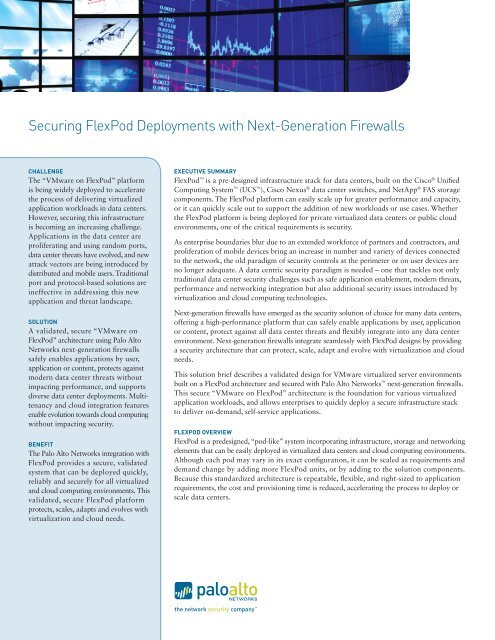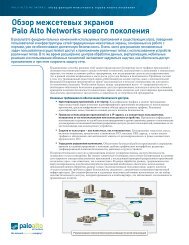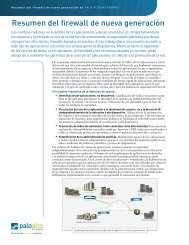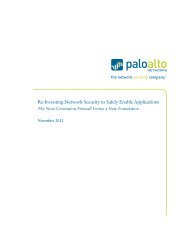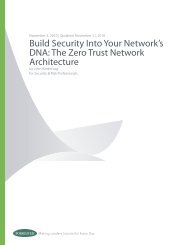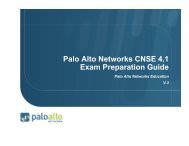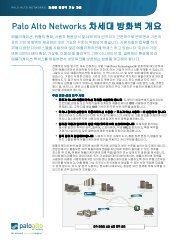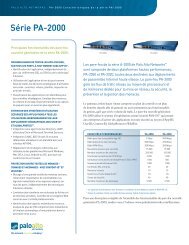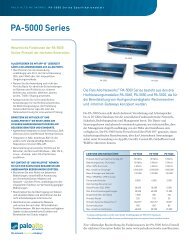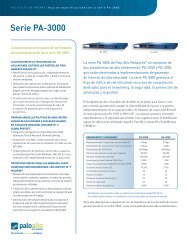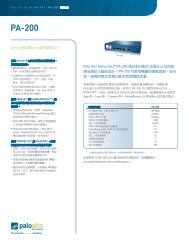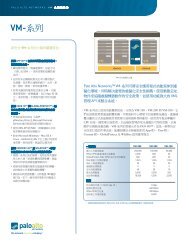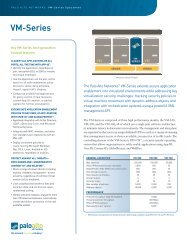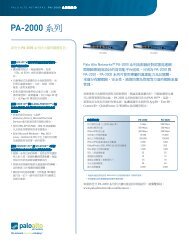Securing FlexPod Deployments with Next-Generation ... - NDM.net
Securing FlexPod Deployments with Next-Generation ... - NDM.net
Securing FlexPod Deployments with Next-Generation ... - NDM.net
You also want an ePaper? Increase the reach of your titles
YUMPU automatically turns print PDFs into web optimized ePapers that Google loves.
<strong>Securing</strong> <strong>FlexPod</strong> <strong>Deployments</strong> <strong>with</strong> <strong>Next</strong>-<strong>Generation</strong> Firewalls<br />
CHALLENGE<br />
The “VMware on <strong>FlexPod</strong>” platform<br />
is being widely deployed to accelerate<br />
the process of delivering virtualized<br />
application workloads in data centers.<br />
However, securing this infrastructure<br />
is becoming an increasing challenge.<br />
Applications in the data center are<br />
proliferating and using random ports,<br />
data center threats have evolved, and new<br />
attack vectors are being introduced by<br />
distributed and mobile users. Traditional<br />
port and protocol-based solutions are<br />
ineffective in addressing this new<br />
application and threat landscape.<br />
SOLUTION<br />
A validated, secure “VMware on<br />
<strong>FlexPod</strong>” architecture using Palo Alto<br />
Networks next-generation firewalls<br />
safely enables applications by user,<br />
application or content, protects against<br />
modern data center threats <strong>with</strong>out<br />
impacting performance, and supports<br />
diverse data center deployments. Multi-<br />
tenancy and cloud integration features<br />
enable evolution towards cloud computing<br />
<strong>with</strong>out impacting security.<br />
BENEFIT<br />
The Palo Alto Networks integration <strong>with</strong><br />
<strong>FlexPod</strong> provides a secure, validated<br />
system that can be deployed quickly,<br />
reliably and securely for all virtualized<br />
and cloud computing environments. This<br />
validated, secure <strong>FlexPod</strong> platform<br />
protects, scales, adapts and evolves <strong>with</strong><br />
virtualization and cloud needs.<br />
EXECUTIVE SUMMARY<br />
<strong>FlexPod</strong> is a pre-designed infrastructure stack for data centers, built on the Cisco ® Unified<br />
Computing System (UCS ), Cisco Nexus ® data center switches, and NetApp ® FAS storage<br />
components. The <strong>FlexPod</strong> platform can easily scale up for greater performance and capacity,<br />
or it can quickly scale out to support the addition of new workloads or use cases. Whether<br />
the <strong>FlexPod</strong> platform is being deployed for private virtualized data centers or public cloud<br />
environments, one of the critical requirements is security.<br />
As enterprise boundaries blur due to an extended workforce of partners and contractors, and<br />
proliferation of mobile devices bring an increase in number and variety of devices connected<br />
to the <strong>net</strong>work, the old paradigm of security controls at the perimeter or on user devices are<br />
no longer adequate. A data centric security paradigm is needed – one that tackles not only<br />
traditional data center security challenges such as safe application enablement, modern threats,<br />
performance and <strong>net</strong>working integration but also additional security issues introduced by<br />
virtualization and cloud computing technologies.<br />
<strong>Next</strong>-generation firewalls have emerged as the security solution of choice for many data centers,<br />
offering a high-performance platform that can safely enable applications by user, application<br />
or content, protect against all data center threats and flexibly integrate into any data center<br />
environment. <strong>Next</strong>-generation firewalls integrate seamlessly <strong>with</strong> <strong>FlexPod</strong> designs by providing<br />
a security architecture that can protect, scale, adapt and evolve <strong>with</strong> virtualization and cloud<br />
needs.<br />
This solution brief describes a validated design for VMware virtualized server environments<br />
built on a <strong>FlexPod</strong> architecture and secured <strong>with</strong> Palo Alto Networks next-generation firewalls.<br />
This secure “VMware on <strong>FlexPod</strong>” architecture is the foundation for various virtualized<br />
application workloads, and allows enterprises to quickly deploy a secure infrastructure stack<br />
to deliver on-demand, self-service applications.<br />
FLEXPOD OVERVIEW<br />
<strong>FlexPod</strong> is a predesigned, “pod-like” system incorporating infrastructure, storage and <strong>net</strong>working<br />
elements that can be easily deployed in virtualized data centers and cloud computing environments.<br />
Although each pod may vary in its exact configuration, it can be scaled as requirements and<br />
demand change by adding more <strong>FlexPod</strong> units, or by adding to the solution components.<br />
Because this standardized architecture is repeatable, flexible, and right-sized to application<br />
requirements, the cost and provisioning time is reduced, accelerating the process to deploy or<br />
scale data centers.
The following components are included in the base <strong>FlexPod</strong><br />
infrastructure stack:<br />
• Cisco Unified Computing Systems: The Cisco UCS is a data<br />
center server platform that integrates a low-latency, 10 Gigabit<br />
Ether<strong>net</strong> (10GbE) unified <strong>net</strong>work fabric <strong>with</strong> enterprise-class,<br />
x86-architecture servers. The system is an integrated, scalable,<br />
multi-chassis platform managed by Cisco UCS Manager. A Cisco<br />
UCS deployment consists of Cisco UCS Fabric Interconnects,<br />
blade server chassis, and blades.<br />
• Cisco Nexus 5000 Series Switches: The Nexus 5000 Series switches<br />
are ideal for data center server access layer and smaller-scale, mid-<br />
market data center aggregation layer deployments in traditional,<br />
virtualized, unified, and high-performance computing environments.<br />
The Cisco Nexus 5000 Series enables any transport over Ether<strong>net</strong>,<br />
including Layer 2 and Layer 3 traffic and storage traffic, on<br />
one common data center platform. The Cisco Nexus family of<br />
switches consists of the Cisco Nexus 5010, 5020, 5548UP, and<br />
5596UP and runs the NX-OS operating system.<br />
• NetApp: The NetApp storage infrastructure uses the Data ONTAP ®<br />
operating system to provide SAN (FCoE, FC, iSCSI), NAS (CIFS,<br />
NFS), and primary and secondary storage in a single unified<br />
platform.<br />
The default hardware for <strong>FlexPod</strong> includes two Cisco Nexus 5548<br />
switches, two Cisco UCS 6120 fabric interconnects, three chassis<br />
of Cisco UCS blades <strong>with</strong> two fabric extenders per chassis, and<br />
NetApp FAS Data Storage Systems. <strong>FlexPod</strong> serves as a foundation<br />
for a variety of data center solutions including server virtualization.<br />
The VMware vSphere built on <strong>FlexPod</strong> solution layers the VMware<br />
vSphere hypervisor on top of the <strong>FlexPod</strong> infrastructure stack. This<br />
solution addresses industry server virtualization needs and simplifies<br />
the evolution to shared infrastructure and cloud architectures.<br />
2 | Palo Alto Networks | <strong>Securing</strong> <strong>FlexPod</strong> <strong>Deployments</strong> <strong>with</strong> <strong>Next</strong>-<strong>Generation</strong> Firewalls<br />
FACTORS AFFECTING THE VIRTUALIZED DATA CENTER<br />
Today’s IT organizations are increasingly tasked <strong>with</strong> doing more<br />
<strong>with</strong> less. In these challenging economic conditions, IT organizations<br />
are faced not only <strong>with</strong> shrinking budgets but are being asked to<br />
improve operational efficiencies and drive responsiveness for<br />
business processes. For many IT organizations, server virtualization<br />
provides many benefits, from operational efficiencies to speed in<br />
application delivery. The efficiency and flexibility afforded by<br />
virtualization is often the first step towards on-demand, measurable<br />
and scalable cloud-services that can more quickly react to<br />
organizational demands.<br />
There have also been changes in the security landscape that impact<br />
the security of the the virtualized data center – changes in how<br />
applications behave, changes in the threat landscape and the<br />
introduction of new attack vectors. These trends have led to a<br />
fundamental shift in how organizations are protecting the data<br />
center, and are critical in the consideration of the appropriate<br />
security solutions for the data center:<br />
Evolving Application Landscape<br />
One of the key missions of the data center is to serve up applications<br />
quickly and reliably. In the data center, business applications that<br />
constitute good traffic should be allowed on the <strong>net</strong>work; other<br />
non-business applications that constitute bad traffic should be blocked<br />
from the <strong>net</strong>work. However, the ability to classify and safely enable<br />
applications is no longer a relatively straightforward exercise.<br />
Applications used to be identified by the ports or ports they used<br />
to communicate, and enforcement of security controls in the data<br />
center involved controlling those ports and protocols. The current<br />
application landscape is very different <strong>with</strong> applications utilizing<br />
non-standard ports, multiple ports or exhibiting evasive techniques<br />
like port-hopping or encryption. The Microsoft SharePoint<br />
application, for example, requires ports TCP 80, TCP 137, TCP<br />
443, TCP 1433, TCP 32843, UDP 138, UDP 139, UDP 1434<br />
and more depending on the specific function to be enabled, and<br />
uses “web” ports even though its primary function is an internal<br />
enterprise collaboration application.<br />
Traditional security solutions that utilize ports and protocol technology<br />
to identify traffic are not effective in this new application landscape.<br />
More importantly, as a result of the lack of visibility, they are helpless<br />
to control and enable these applications amidst an environment of<br />
application proliferation and misuse of privileges. Virtualization<br />
technology has created an atmosphere of ease of application delivery,<br />
where it is easier for application developers to implement applications<br />
on any open port, than to wait for security to make policy changes<br />
on firewalls. Many of these application developers are using<br />
management ports like SSH, Tel<strong>net</strong>, RDP for remote management,<br />
and misuse of these ports can serve as a security backdoor for<br />
attackers to infiltrate. The challenge in the data center is therefore<br />
a lack of visibility and control.
New Threat Landscape<br />
The threat landscape has shifted dramatically from notoriety-based<br />
attacks to cybercriminal and nation-state attacks <strong>with</strong> the objective<br />
of gaining data to exploit for financial or geopolitical purposes.<br />
Threats are delivered via a variety of different vectors, from<br />
application-enabled vectors and exploits to high-risk URLs and<br />
malware. In many cases, enterprises are exposed to targeted and<br />
customized malware, which can easily pass undetected through<br />
traditional antivirus solutions. The impact of targeted attacks has<br />
been significant on organizations such as Sony, Nortel, Symantec,<br />
RSA, Comodo, DigiNotar. The financial implications from these<br />
attacks have been in the millions and in the case of DigiNotar,<br />
have brought the company to bankruptcy and insolvency.<br />
In many data centers, security solutions exist in silos, i.e. firewalls<br />
<strong>with</strong> firewall helpers like IPS and anti-virus appliances behind<br />
them. These solutions all have blind spots because their foundation<br />
is built on an assumption of the traffic based on ports and protocols.<br />
In addition, threats that coordinate multiple disciplines cannot be<br />
addressed in a coordinated integrated fashion by these siloed<br />
technologies. Unknown threats or targeted malware also cannot be<br />
addressed by traditional security solutions that create signatures<br />
based on common threats in the wild.<br />
Distributed Enterprise<br />
Data center access has also changed. Empowered users are accessing<br />
the data center from a variety of devices, including laptops, tablets,<br />
and phones and from a variety of locations. The expectation of<br />
anytime anywhere “workspaces” for these users enable new gains<br />
in productivity, but also now leads to new data center challenges<br />
in securely enabling access based on user, application, device-type<br />
access and content. The distributed enterprise now also includes<br />
an ecosystem of partners, contractors, supply chains, and customers<br />
requiring access to the <strong>net</strong>work for collaboration on business<br />
projects. Data center compliance challenges abound in tracking<br />
data, and enabling secure access for these extended users. More<br />
importantly, these distributed users also provide a new attack<br />
vector for the data center. Many attacks take advantage of partner<br />
and contractor environments that are not fully secured to launch<br />
attacks on an organization.<br />
SECURITY CONSIDERATIONS FOR A FLEXPOD DESIGN<br />
The security considerations in a <strong>FlexPod</strong> design must therefore<br />
consider the implications of the current application and threat<br />
landscape and new access control challenges outlined in the previous<br />
section, as well as the challenges introduced by a virtualized<br />
infrastructure. They include:<br />
• Safe Application Enablement: The ability to safely enable<br />
applications in the data center is the key te<strong>net</strong> of the security<br />
solution in the data center. Safe enablement of applications<br />
means the ability to transform your traditional allow or deny<br />
firewall policy into meaningful business –relevant elements such<br />
as the application identity, who is using the application and the<br />
type of content or threat to control access. From a security<br />
solution, this means the ability to identify and control applications<br />
in the data center, the ability to enable these applications by user<br />
and user group instead of IP addresses, and being able to inspect<br />
all content for threats. In addition, the ability to manage unknown<br />
applications is also important in a data center environment<br />
where many applications may be home-grown or custom.<br />
• Meaningful Segmentation: One of the benefits of visibility into<br />
applications, users and content is the ability to deliver meaningful<br />
segmentation. This is important to segment off physical servers<br />
or virtual workloads that are running proprietary or confidential<br />
information, or to isolate vulnerable parts of the data center.<br />
Meaningful segmentation contains and limits access, and delivers<br />
individual accountability. Having that level of control, and<br />
perhaps most importantly, auditability, is indispensable to meet<br />
compliance requirements.<br />
• Comprehensive Threat Protection: As described earlier, the threat<br />
landscape has now evolved to patient, multi-step intrusions that<br />
leverage a number of different vectors to infect then pe<strong>net</strong>rate<br />
the <strong>net</strong>work. An integrated threat solution must first start <strong>with</strong><br />
the ability to limit the scope of attack by blocking risky or rogue<br />
applications in the data center. Then, the same threat prevention<br />
solution must be able to address a variety of coordinated threats<br />
in one integrated framework, and finally tackle unknown threats.<br />
An important requirement of the data center threat protection<br />
solution is the ability to easily adapt to a change in security<br />
posture due to evolving data center requirements.<br />
• Data Filtering and File Blocking: In a data center environment,<br />
understanding the type of data that is stored in the data center<br />
and controlling access to that data is important. A <strong>net</strong>work<br />
security solution in the data center should provide a means to<br />
track unauthorized file and data transfer, such as the ability to<br />
block files by type, and identify and control the transfer of<br />
sensitive data patterns like credit card or social security numbers<br />
in encrypted files.<br />
Palo Alto Networks | <strong>Securing</strong> <strong>FlexPod</strong> <strong>Deployments</strong> <strong>with</strong> <strong>Next</strong>-<strong>Generation</strong> Firewalls | 3
• High-throughput, Low-latency Performance: Meeting performance<br />
requirements is complementary to addressing threat prevention<br />
requirements. Traditional threat prevention solutions degrade<br />
in performance every time a new threat prevention feature is<br />
enabled. Threat prevention solutions that do not meet performance<br />
requirements do not belong in the data center because of the<br />
impact to the mission of the data center to serves its customers.<br />
The ability to deliver a high-performing, high-throughput <strong>net</strong>work<br />
security solution in the data center is critical.<br />
• Multi-tenancy: <strong>FlexPod</strong> environments can be deployed as multitenant<br />
cloud computing environments that support large numbers<br />
of customers and platforms to achieve cost benefits and economies<br />
of scale. Multi-tenancy from multiple customers sharing the use of<br />
a common infrastructure or platform can lead to higher security<br />
risks. For example, security breaches <strong>with</strong> one customer or<br />
organization’s <strong>net</strong>work can expose another customer’s <strong>net</strong>work<br />
to the same attack if the cloud computing environment is not<br />
properly segmented.<br />
• Cloud Integration: Data center environments typically automate<br />
the tasks and processes using workflows that help IT teams<br />
execute change <strong>with</strong> greater speed, quality, and consistency.<br />
Deployment of security capabilities typically lags the speed of<br />
orchestration software provisioning for virtual environments,<br />
leading to security risks. An automated way to provision <strong>net</strong>work<br />
security in line <strong>with</strong> the pace of orchestration of the virtualized<br />
data center environment is needed.<br />
• One Policy, One Management: It is important to have a seamless,<br />
centralized way to manage data center <strong>net</strong>work security solutions.<br />
Regardless of the types of <strong>net</strong>work security functions that are<br />
enabled, policies need to be managed centrally, and the <strong>net</strong>work<br />
security rule base should have one unified policy that delivers a<br />
single comprehensive management pane for the data center.<br />
Otherwise, access control policies can become convoluted,<br />
leading to policy complexities, misconfiguration and ultimately<br />
security blind spots.<br />
4 | Palo Alto Networks | <strong>Securing</strong> <strong>FlexPod</strong> <strong>Deployments</strong> <strong>with</strong> <strong>Next</strong>-<strong>Generation</strong> Firewalls<br />
NEXT-GENERATION FIREWALLS SECURE FLEXPOD DESIGNS<br />
The Palo Alto Networks next-generation firewall is the only <strong>net</strong>work<br />
security solution that can deliver a next-generation data center<br />
solution suite at true data center speeds. Palo Alto Networks next-<br />
generation firewalls address security requirements, from the ability<br />
to address the new application and threat landscape, to delivering<br />
a high-performance architecture and cloud-integration features.<br />
More importantly, next-generation firewalls provide flexibility in the<br />
data center– from the ability to adjust security postures as needed,<br />
simplified infrastructure that integrates at multiple layers of the<br />
<strong>net</strong>work, and the ability to standardize on one next-generation<br />
platform for any data center <strong>net</strong>work security needs. These<br />
characteristics are all important factors of why next-generation<br />
firewalls in <strong>FlexPod</strong> designs deliver a security architecture that can<br />
protect, scale, adapt and evolve <strong>with</strong> virtualization and cloud needs.<br />
The following are key benefits of next-generation firewalls in<br />
<strong>FlexPod</strong> designs:<br />
• Safe Application Enablement: Palo Alto Networks next-generation<br />
firewalls allow organizations to safely enable applications in<br />
<strong>FlexPod</strong> environments. This is achieved via three technologies –<br />
App-ID , User-ID and Content-ID . App-ID identifies applications<br />
in the data center and reduces the scope of attacks by controlling<br />
applications like peer-to-peer applications, circumventors and<br />
proxies. Then, as specific applications and associated features<br />
are enabled, virus, vulnerability exploit, spyware and modern<br />
malware protection features can extend the application-specific<br />
context into threat prevention. For example, policies can enable<br />
Oracle on its standard port only for finance and operations<br />
and protect against SQL injection attacks and Oracle specific<br />
vulnerability exploits.<br />
Content-ID capabilities provide a complete threat framework,<br />
from anti-virus and anti-malware features to intrusion prevention<br />
features that block <strong>net</strong>work and application-layer vulnerability<br />
exploits. In addition, for Inter<strong>net</strong>-facing data centers, denial-of-<br />
service features can control various types of traffic floods. Finally,<br />
WildFireTM provides the ability to identify malicious behaviors<br />
in executable files by running them in a virtual environment and<br />
observing their behaviors. This enables Palo Alto Networks<br />
next-generation firewalls to identify malware quickly and accurately,<br />
even if the particular sample of malware has never been seen in<br />
the wild before.<br />
• Strong Networking Integration: Palo Alto Networks next-generation<br />
firewalls support more deployment options than any other device<br />
in the <strong>net</strong>work security market. Integration can occur at Layer-1,<br />
Layer-2, Layer-3, and tap modes (or a mixture of all on the same<br />
appliance). Strong <strong>net</strong>working features such as VLAN trunking,<br />
link aggregation and high availability deployment provide the<br />
foundation to easily integrate into the data center architecture<br />
in order to leverage the next-generation firewall technologies.
• Superior High-performance Architecture: The Palo Alto Networks<br />
single-pass software architecture offers superior performance<br />
compared to traditional approaches, including those<br />
found in a UTM or software blade approach. This is because<br />
of the unique architecture that processes functions in a single<br />
pass to reduce latency, allowing organizations to simplify their<br />
<strong>net</strong>work security infrastructure and to eliminate the need for a<br />
variety of stand-alone and bolt-on security devices. Palo Alto<br />
Networks next-generation firewall appliances combine the<br />
single-pass software architecture <strong>with</strong> parallel processing hardware<br />
architecture, <strong>with</strong> dedicated, specialized processing for<br />
<strong>net</strong>working, security, and content scanning so that the full suite<br />
of next-generation features can be enabled <strong>with</strong> high throughput<br />
and reliability.<br />
• Multi-tenancy: Virtual systems are unique and distinct nextgeneration<br />
firewall instances <strong>with</strong>in a single Palo Alto Networks<br />
firewall. Rather than deploy many individual firewalls, a single<br />
pair of firewalls can be deployed and partitioned into a series<br />
of virtual firewall instances or virtual systems. Each virtual<br />
system is a self-contained, fully operational Palo Alto Networks<br />
firewall, complete <strong>with</strong> separate management interfaces which<br />
ensures that other customer or departmental virtual systems<br />
will only see or modify their own policies. Within each virtual<br />
system, role-based administrative access control allows organizations<br />
to delegate feature level administrative access (enabled,<br />
read-only, or disabled and hidden from view) to different staff<br />
members.<br />
• Centralized Management: Panorama is a centralized security<br />
management system that provides global control over<br />
a <strong>net</strong>work of Palo Alto Networks next-generation firewalls.<br />
Panorama allows administrators to control all aspects of the<br />
devices and/or virtual systems under management (security,<br />
NAT, QoS, policy based forwarding, decryption, application<br />
override, captive portal, and DoS protection). Using pre- and<br />
post-rules, Panorama administrators can enforce shared policies<br />
while allowing local policy flexibility. Rules in between the pre-<br />
and post-rules can be edited locally or by a Panorama administrator<br />
who has switched to the local firewall context. Software<br />
updates such as dynamic content updates (Applications, Threats<br />
and antivirus), and software licenses can also be managed centrally<br />
on Panorama.<br />
Panorama provides the ability to view logs and run reports<br />
across dynamic or locally queried data aggregated from managed<br />
devices. Distributed reporting can be done <strong>with</strong>out a need<br />
to forward logs from firewalls to Panorama. Aggregate user<br />
activity reports can be run for mobile users that access cloud<br />
resources from different locations. This will report users’ activity<br />
regardless of where they are currently located globally.<br />
SECURE FLEXPOD DESIGN WITH PALO ALTO NETWORKS FIREWALLS<br />
In this validated design, a VMware VSphere virtualized environment<br />
was built on top of a <strong>FlexPod</strong> infrastructure. Microsoft SharePoint,<br />
Microsoft SQL and Microsoft Exchange Active Directory virtualized<br />
applications were deployed on this virtualized data center platform.<br />
A pair of Palo Alto Networks PA-5060 was deployed in highavailability<br />
layer 3 mode to secure this <strong>FlexPod</strong> design.<br />
Figure 1: Secure <strong>FlexPod</strong> Design<br />
• Firewall Mode: The Palo Alto Networks next-generation firewall<br />
can be deployed in Layer-1 (virtual wire), Layer-2 and Layer-3.<br />
In this case, Layer-3 mode was selected. In a Layer-3 deployment,<br />
the firewall routes traffic between multiple interfaces in the <strong>FlexPod</strong><br />
design. An IP address must be assigned to each interface and a<br />
virtual router must be defined to route the traffic. Layer-3 mode<br />
is the most common firewall deployment topology in the data<br />
center, and is also ideal for <strong>net</strong>work segmentation deployments<br />
for <strong>FlexPod</strong> designs.<br />
Palo Alto Networks | <strong>Securing</strong> <strong>FlexPod</strong> <strong>Deployments</strong> <strong>with</strong> <strong>Next</strong>-<strong>Generation</strong> Firewalls | 5
• High-availability: The Palo Alto Networks next-generation<br />
firewalls were deployed in active/passive pairs, so that if the<br />
active firewall fails for any reason, the passive firewall becomes<br />
active automatically <strong>with</strong> no loss of service. A failover can also<br />
occur if selected Ether<strong>net</strong> links fail or if the active firewall cannot<br />
reach one or more of the specified destinations. Note that an<br />
alternative design is possible using load balancers to load balance<br />
the traffic between multiple pairs of Palo Alto Network firewalls.<br />
The addition of the load balancers will address higher firewall<br />
throughput and scalability requirements in the <strong>FlexPod</strong> design.<br />
More firewalls can be added to the load balancing design as<br />
scalability requirements increase.<br />
• Security Zones: In data center deployments, virtualized applications<br />
should be segmented appropriately into security zones based<br />
on similar risk factors and security classification. In this design,<br />
Palo Alto Networks next-generation firewalls segmented the<br />
virtualized applications into appropriate zones and access to<br />
those zones was restricted based on application, user and content.<br />
Common infrastructure such as Active Directory is sometimes<br />
the most vulnerable and critical, because they can typically<br />
communicate <strong>with</strong> all other services. In this design, each of the<br />
applications - Microsoft SharePoint, Microsoft SQL and Active<br />
Directory were segmented into their own unique zone. By default,<br />
traffic is not allowed between zones, therefore a specific policy<br />
must be defined to allow Microsoft SharePoint to communicate<br />
<strong>with</strong> MS-SQL and Active Directory.<br />
6 | Palo Alto Networks | <strong>Securing</strong> <strong>FlexPod</strong> <strong>Deployments</strong> <strong>with</strong> <strong>Next</strong>-<strong>Generation</strong> Firewalls<br />
• Safe Application Enablement: The applications in this <strong>FlexPod</strong><br />
design included Microsoft SharePoint, Microsoft SQL and<br />
Microsoft Exchange Active Directory. With a traditional port-based<br />
security solution, multiple ports would have to be opened for<br />
these applications that would create blind spots for the <strong>net</strong>work.<br />
For example, Microsoft SharePoint uses ports 80, 443, 135, 137,<br />
139 and more which would have enabled firewall access not only<br />
for web-based applications but by other Microsoft applications<br />
that use these common ports.<br />
With Palo Alto Networks next-generation firewalls, safe application<br />
enablement capabilities powered by App-ID, User-ID and<br />
Content-ID, identified these applications and enable them based<br />
on user, application and content to ensure compliance <strong>with</strong> data<br />
center policies. With the visibility provided by App-ID, and User-ID,<br />
additional policies can be enabled if desired:<br />
• Allow all employees, partners and contractors to use Microsoft<br />
SharePoint features such as blog, and calendar, but only users<br />
<strong>with</strong> the right security clearance can access documents.<br />
• Allow only the IT group to use a fixed set of remote management<br />
applications (e.g., SSH, RDP, Tel<strong>net</strong>) across their standard<br />
ports to manage these applications but block their use for<br />
all other users. Limiting user privileges, and controlling rogue<br />
admins is a good best practice for security.<br />
App-ID will also enable unknown traffic to be characterized. Any<br />
traffic that is unknown can be further investigated to determine<br />
whether they are uncategorized applications or threats in the<br />
data center.<br />
• Threat Protection & SSL Decryption: Content-ID was enabled<br />
in this design to not only deliver application content inspection<br />
for safe application enablement, but also for overall data center<br />
protection. In addition, SSL decryption was enabled to ensure<br />
that threats were not hidden in encrypted tunnels.<br />
• Management: Both sets of firewalls were managed by Panorama.<br />
All traffic was inspected and logged centrally on Panorama.<br />
• Platform: This design was tested and validated <strong>with</strong> the PA-5060,<br />
one of the data center models in the PA-5000 Series. The PA-5000<br />
Series comprises three models—the PA-5020, the PA-5050 and<br />
PA-5060 at 5 Gbps, 10 Gbps and 20 Gbps firewall throughput<br />
respectively, <strong>with</strong> App-ID enabled. The PA-5000 Series of nextgeneration<br />
firewalls is designed to protect data centers, large<br />
enterprise Inter<strong>net</strong> gateways, and service provider environments<br />
where traffic demands dictate predictable firewall and threat<br />
prevention throughput. The PA-5000 Series is powered by more<br />
than 40 processors distributed across four functional areas:<br />
<strong>net</strong>working, security, content inspection and management. Reliability<br />
and resiliency is delivered by active/active or active/passive high<br />
availability; physical separation of data and control plane; and<br />
redundant, hot swappable components.
The firewall rule base for the validated design is shown below:<br />
Figure 2: Secure VMware on <strong>FlexPod</strong> firewall policies for<br />
SharePoint, Microsoft SQL and Microsoft Exchange Server<br />
Active Directory<br />
These additional optional features can be enabled for the <strong>FlexPod</strong> design:<br />
• Cloud Integration: Palo Alto Networks offers a powerful XML management API that enables external cloud orchestration software<br />
to connect over an encrypted SSL link to manage and configure Palo Alto Networks firewalls. The exhaustive and fully-documented<br />
REST-based API allows configuration parameters to be seen, set and modified as needed. For example, when the virtual machine for<br />
SharePoint is instantiated, Palo Alto Networks security policies for SharePoint are triggered to ensure that organizational security<br />
policies are strictly enforced.<br />
• <strong>Securing</strong> Access to the Data Center: Depending on the topology of the cloud environment, this same set of next-generation firewalls may<br />
also serve as VPN gateway (not shown in diagram). Access to cloud resources or data center for mobile users or partners/contractors<br />
accessing the data center is provided by an encrypted GlobalProtect VPN tunnel using two-factor authentication, and <strong>with</strong> host-level<br />
protection for diverse endpoints.<br />
SUMMARY<br />
The <strong>FlexPod</strong> platform provides a scalable, data center platform for virtualization and cloud computing needs. Palo Alto Networks nextgeneration<br />
firewalls integrate seamlessly <strong>with</strong> <strong>FlexPod</strong> designs by providing a security architecture that can protect, scale, adapt and<br />
evolve. The validated secure “VMware on <strong>FlexPod</strong>” architecture provides the foundation for various virtualized application workloads,<br />
and allows enterprises to quickly deploy a secure infrastructure stack to deliver on-demand, self-service applications for data centers.<br />
3300 Olcott Street<br />
Santa Clara, CA 95054<br />
Main: +1.408.573.4000<br />
Sales: +1.866.320.4788<br />
Support: +1.866.898.9087<br />
www.paloalto<strong>net</strong>works.com<br />
Copyright ©2012, Palo Alto Networks, Inc. All rights reserved. Palo Alto Networks,<br />
the Palo Alto Networks Logo, PAN-OS, App-ID and Panorama are trademarks of<br />
Palo Alto Networks, Inc. All specifications are subject to change <strong>with</strong>out notice.<br />
Palo Alto Networks assumes no responsibility for any inaccuracies in this document<br />
or for any obligation to update information in this document. Palo Alto Networks<br />
reserves the right to change, modify, transfer, or otherwise revise this publication<br />
<strong>with</strong>out notice. PAN_SB_FP_082412


